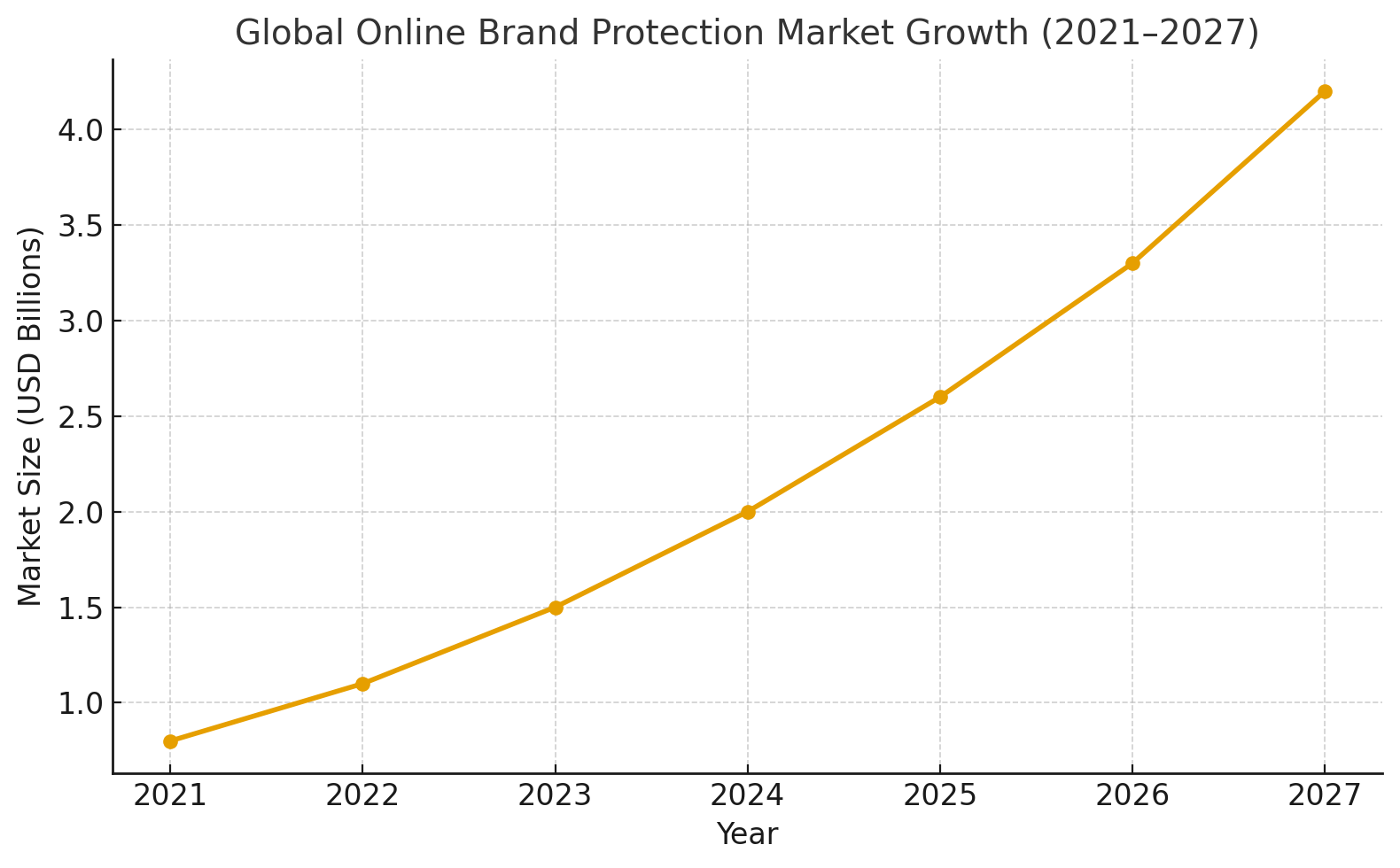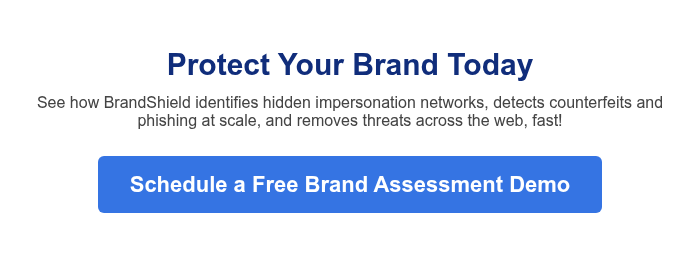Online Brand Protection for Businesses in 2026 [Complete Guide]
Online brand abuse is accelerating across every digital channel. Counterfeit networks, AI‑driven phishing scams, fake domains, impersonation accounts, and dark‑web marketplaces now operate at a scale that did not exist even a few years ago. BrandShield threat data shows that brand impersonation attempts have continued to climb month over month throughout 2025, particularly across social platforms and unregulated e‑commerce ecosystems. As businesses enter 2026, online brand protection is no longer a support function. It is a core operational requirement for any company that relies on digital trust.
Introduction
BrandShield’s guide to online brand protection in 2026 outlines the real risks, the expanding threat landscape, and the actions every business must take to safeguard their reputation and revenue. The volume of fraud targeting consumers is increasing, and the tactics used by impersonators are becoming more sophisticated. Generative AI now allows criminals to produce realistic fake websites, professional‑looking counterfeit ads, and convincing customer service impersonations at a scale that was previously impossible. As this technology becomes accessible to anyone, brands must strengthen their defensive posture.
This guide presents a complete view of what online brand protection means, the threats brands face in 2026, and the strategic steps required to protect your business. It also includes sample use cases, practical recommendations, and a clear framework for implementing a modern brand protection program.
What Is Online Brand Protection
Online brand protection is the continuous monitoring and enforcement of activities that threaten a company’s identity, customers, products, and reputation. It includes detecting counterfeit products, shutting down fraudulent websites, identifying social media impersonators, monitoring the dark web for leaked information, and removing content that misuses a brand’s intellectual property.
The purpose of brand protection is simple. It prevents bad actors from exploiting your name, your content, or your customers. It also protects business continuity by stopping fraud that can divert sales, damage trust, and expose consumers to financial or physical harm. In 2026, the scope of brand protection covers more channels than ever before. Brands must now monitor traditional websites, search engines, social platforms, marketplaces, app stores, AI engines, messaging platforms, and decentralized digital spaces.
Why Businesses of All Sizes Need Online Brand Protection
The assumption that only large enterprises face brand impersonation is incorrect. Small and midsize businesses are now frequent targets because they lack strong security controls and have limited internal resources. Criminals imitate well known brands to lure victims, but they exploit the weaker defenses of small companies to distribute scams, fake ads, and malicious content.
When a business experiences brand abuse, the consequences extend far beyond a single incident.
Reputation Damage and Loss of Trust
Consumers expect brands to safeguard their identity. When customers encounter a fake domain, a counterfeit product, or a fraudulent profile that uses your brand’s name, they associate the failure directly with you. Studies consistently show that the majority of consumers will stop trusting a brand after a security incident, even if the company was not technically responsible for the abuse.
Revenue Loss and Market Diversion
Fraud diverts sales to counterfeit sellers, manipulates search engine rankings, inflates advertising costs, and shifts traffic from legitimate channels to fake stores. The impact is immediate and measurable. Revenue declines, customer acquisition becomes more expensive, and new audiences discover the counterfeit version of your brand before they ever reach the official one.
Consumer Safety Risks
Counterfeit products create physical and financial risk. Fraudulent websites steal credit card information. Fake support agents collect personal data. Impersonation emails lead victims to download malware. The people harmed are your customers, and they hold your brand accountable.
Legal and Compliance Exposure
Unauthorized use of trademarks, logos, and intellectual property can push companies into costly legal disputes. Regulators increasingly expect businesses to take proactive measures to protect consumers from fraud. When a brand fails to act, liability becomes a real concern.
Benefits of BrandShield for Online Brand Protection
BrandShield provides a complete solution that helps companies prevent, detect, and eliminate threats across the modern digital landscape.
Comprehensive Monitoring Across All Channels
BrandShield continuously scans domains, social media platforms, marketplaces, mobile app stores, and dark web forums. AI models detect fake profiles, fraudulent listings, cloned websites, suspicious domains, and malicious content in real time.
Actionable Insights and Prioritization
Threat detection alone is not enough. Organizations need clear intelligence that identifies severity, urgency, and business impact. BrandShield delivers prioritized alerts, evidence packages, and automated recommendations that accelerate decision making.
Automated Enforcement and Takedowns
BrandShield executes verified takedowns directly with platforms, registrars, marketplaces, and hosting providers. Automated workflows reduce response time from days to minutes and remove fraudulent content before consumers are harmed.
Expert Analyst Support
Human expertise remains essential. BrandShield’s analysts review alerts, validate threats, track emerging abuse patterns, and ensure enforcement actions adhere to each platform’s guidelines.
Key Online Threats to Brands in 2026
The threat landscape now includes multiple attack types that require coordinated defense.
Phishing Attacks and Social Engineering
Phishing remains the most widespread form of brand abuse. Fake login pages, spoofed customer service messages, and fraudulent promotional emails mislead customers into sharing credentials or making payments. AI powered phishing is becoming harder to detect, increasing the need for domain monitoring and enforcement.
Cybersquatting and Domain Impersonation
Attackers register domains that resemble your own, using minor variations in spelling or characters. These sites host phishing pages, malware downloads, or counterfeit storefronts. In 2024 and 2025, domain dispute filings increased significantly, proving that the problem is expanding.
Counterfeit Products Across Marketplaces
Organized counterfeit networks use global marketplaces to sell fake goods that appear identical to genuine products. These listings damage revenue and erode trust. AI-generated reviews amplify the problem by creating a false perception of quality.
Fake Reviews and Manipulated Ratings
Counterfeit sellers publish fake positive reviews on their listings and fake negative reviews on official brand listings. This distorts buyer perception and undermines legitimate SEO and marketplace ranking signals.
Copyright and Content Infringement
Fraudulent operators steal brand images, videos, product descriptions, and marketing materials. They use them to build fake stores or social ads that seem authentic. Copyright misuse is now one of the most common early indicators of a new impersonation campaign.
Negative SEO and Search Manipulation
Fake backlinks. Keyword stuffing. Spam domains. Scraped content. Attackers manipulate search results to outrank legitimate brands or redirect traffic to malicious sites.
Sample Use Case: Marketplace Counterfeits
A global retail brand noticed declining sales across key regions. BrandShield detected an expanding counterfeit operation across multiple marketplaces, each using stolen images and AI generated reviews. By deploying automated marketplace monitoring and instant takedowns, the brand removed hundreds of listings in less than sixty days. Revenue recovered in the following quarter and customer support complaints fell significantly. This example illustrates how structured monitoring and enforcement change outcomes quickly.
Sample Use Case: Social Media Impersonation
A health and wellness company found dozens of profiles impersonating their founder across Instagram and TikTok. BrandShield detected the accounts, verified the identity misuse, and removed them quickly. The company avoided a potential misinformation event that could have affected thousands of customers.

How To Protect Your Brand Online: A Strategic Framework
1. Conduct a Complete Brand Protection Audit
Map assets, identify exposure points, document variations of your brand name, evaluate domain footprints, and assess executive risk. Include the deep and dark web in the analysis to understand the full attack surface.
2. Establish Proactive Protection Measures
Register trademarks, domains, and social accounts including common variations. Maintain a strong online presence to prevent impersonators from occupying unclaimed spaces.
3. Implement Continuous Monitoring and Automation
Automated detection is required to identify threats across hundreds of channels in real time. Manual monitoring cannot scale to meet current threat volumes.
4. Combine Machine Intelligence With Human Expertise
AI identifies threats. Human analysts verify, prioritize, and escalate them. Together they deliver accurate intelligence and prevent false positives.
BrandShield’s hybrid approach to online brand protection combines the speed and scale of AI with the precision and context of expert human analysts. This dual system ensures threats are identified early, validated quickly, and addressed efficiently—without the noise of false positives or low-priority alerts.
5. Execute Adversary Disruption and Fast Remediation
Threat removal must be comprehensive. This includes shutting down fake profiles, removing counterfeit listings, eliminating fraudulent domains, blocking malicious URLs, and monitoring for reemergence.
Choosing the Right Brand Protection Solution
A modern brand protection platform must provide global coverage, AI powered detection, scalable enforcement, human expertise, and end to end visibility. Without automation and coordinated takedown workflows, brands cannot respond at the speed required to protect customers.
Conclusion
The digital environment in 2026 is more complex and more dangerous than ever. Online brand abuse grows every year, and AI has accelerated the scale and sophistication of attacks. Companies that fail to invest in brand protection expose themselves to revenue loss, reputational harm, consumer risk, and irreversible damage to trust.
BrandShield provides the technology, intelligence, and enforcement required to safeguard brands across the modern digital landscape. By combining continuous monitoring, automated removals, and expert analysis, BrandShield enables businesses to protect their identity, defend their customers, and maintain control of their reputation.
If you are ready to strengthen your defensive posture and eliminate threats before they impact your business, contact BrandShield and begin building your brand protection strategy for 2026.
Frequently Asked Questions (FAQ)
What is online brand protection?
Online brand protection refers to the strategies and tools used to detect, prevent, and remove unauthorized use of a company’s brand assets across digital channels. This includes combating counterfeit listings, impersonation, domain fraud, phishing, and misuse of logos or content across websites, social media, marketplaces, and the dark web.
Why is online brand protection important in 2026?
With the rapid growth of AI generated content, fake marketplaces, and impersonation scams, brands are more vulnerable than ever. Online brand protection helps maintain customer trust, secure revenue, and defend a company’s digital identity against rising fraud and abuse.
What specific threats does BrandShield help detect?
BrandShield detects threats such as counterfeit product listings, phishing domains, executive impersonations, fake social media profiles, unauthorized app clones, dark web mentions, and fraudulent ad campaigns across global platforms and regions.
How does BrandShield combine AI and human expertise?
BrandShield’s AI scans online environments at scale, identifying suspicious behavior, brand misuse, or potential fraud. Human analysts then verify, prioritize, and escalate verified threats to ensure accuracy, relevance, and fast enforcement while avoiding false positives.
Which platforms does BrandShield monitor?
BrandShield covers all major digital environments including Amazon, eBay, Alibaba, Shopee, TikTok, Instagram, Facebook, X (formerly Twitter), LinkedIn, Reddit, domain registrars, mobile app stores, and surface web, deep web, and dark web forums.
Can BrandShield remove infringing content?
Yes. BrandShield offers integrated enforcement workflows that submit takedown requests directly to platforms, domain hosts, and social networks. The platform also tracks the success of each enforcement action and provides reporting on takedown status.
Is BrandShield only for large enterprises?
No. While BrandShield supports global enterprises, it also provides scalable solutions for SMBs and growing brands. The platform adapts to your brand’s footprint whether you’re managing a few core domains or a global marketplace presence.
How long does it take to detect and remove threats?
Initial threat detection occurs in real time. Once verified by analysts, takedowns are submitted promptly, often within hours. Final resolution timelines depend on the responsiveness of third party platforms but are actively tracked by BrandShield.
Does BrandShield provide reporting?
Yes. Clients receive real time dashboards and scheduled threat intelligence reports, including detailed summaries of detections, takedowns, ROI metrics, threat sources, geolocation breakdowns, and enforcement performance trends.
How is BrandShield different from other providers?
BrandShield offers deeper marketplace coverage, real time dark web visibility, analyst verified enforcement, and a hybrid AI and human detection engine that significantly reduces false positives. Unlike passive alert tools, BrandShield acts swiftly to disrupt threats.
![Online Brand Protection for Businesses in 2026 [Complete Guide]](https://www.brandshield.com/wp-content/uploads/2025/11/Online-Brand-Protection-for-Businesses-in-2026.png)
